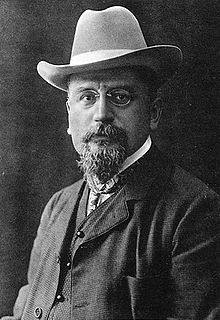20:
126:" and "ideoplastic". He described physioplastic as direct reproduction of the object or its immediate image in memory, and ideoplastic as an intuitive attempt to create what the eye sees.
405:
410:
400:
130:
122:. In his studies of art, he believed that there were two types of style and aims of artistic representation. These two concepts he called "
309:
297:
104:
and considered that all physiological phenomena seen in higher animals may already be recognizable in the most basic forms of life.
385:
352:
380:
80:
Max
Verworn is remembered for his research in the field of experimental physiology, and especially for his work involving
54:
229:
111:, he proposed "conditionalism" to describe a state or process determined by totality of its processes.
395:
390:
340:
346:
336:
280:
221:
70:
58:
365:
66:
270:
146:
42:
233:
213:
171:
119:
81:
84:. He did extensive studies of the elementary physiological processes that take place in
133:" (or the National Academy of Germany) in 1896 for his work in the area of physiology.
332:
374:
217:
193:
123:
85:
50:
300:
The
Psychology of Jung: An Introduction with Illustrations by Jolande Székács Jacobi
19:
284:
101:
93:
31:
345:"Parts of this article are based on a translation of an equivalent article at the
62:
225:
97:
89:
77:(Journal of General Physiology), and was its publisher until his death in 1921.
206:
Die biologischen
Grundlagen der Kulturpolitik. Eine Betrachtung zum Weltkriege.
115:
108:
310:
Science, Technology, and the Art of
Medicine: European-American Dialogues
321:
149:
275:
35:
258:
18:
46:
61:, and in 1901 a professor at the physiological institute at
92:
and sensory organs. He conducted research in the fields of
366:
Dynamic and
Statistical Regularity in Physics and Biology
129:
He was the first recipient of the Carus Prize from the "
312:
edited by C. Delkeskamp-Hayes, Mary Ann
Gardell Cutter
57:(1841–1897). In 1895 he became a professor at the
30:(4 November 1863 – 23 November 1921) was a German
202:, 1908 - The question on the limits of knowledge.
353:Theories of Art: From Impressionism to Kandinsky
100:. Verworn was influenced by Haeckel's theory of
131:Deutsche Akademie der Naturforscher Leopoldina
406:Academic staff of the University of Göttingen
8:
158:, 1892 - Movement of the living substances.
69:(1829-1910), he became a professor at the
274:
200:Die Frage nach den Grenzen der Erkenntnis
411:Academic staff of the University of Jena
401:Academic staff of the University of Bonn
249:
114:He undertook investigations into human
73:(1910). In 1902 he founded the journal
324:Handwörterbuch der naturwissenschaften
238:Handwörterbuch der naturwissenschaften
75:Zeitschrift für Allgemeine Physiologie
49:, where he furthered his studies with
186:, 1907 - Mechanics of spiritual life.
143:Psychophysiologische Protistenstudien
7:
190:Zur Psychologie der primitiven Kunst
178:Naturwissenschaft und Weltanschauung
156:Die Bewegung der lebendigen Substanz
107:In his opposition to the concept of
14:
180:, 1904 - Science and philosophy.
184:Die Mechanik des Geisteslebens
45:in Berlin, and later moved to
28:Max Richard Constantin Verworn
1:
259:"Obituary: Prof. Max Verworn"
164:, 1895 - General physiology.
427:
236:, he was co-author of the
208:, II Auflage, Jena, 1916.
65:. Later, as successor to
257:C., E. P. (1922-02-06).
41:He studied medicine and
192:, 1907 - Psychology of
23:Max Verworn (1863-1921)
386:Scientists from Berlin
347:French Knowledge (XXG)
162:Allgemeine Physiologie
137:Selected written works
55:William Thierry Preyer
24:
230:Hermann Theodor Simon
22:
381:German physiologists
341:Max Planck Institute
218:Gottlob Eduard Linck
34:who was a native of
172:biogenic hypothesis
168:Die Biogenhypothese
147:Psychophysiological
82:cellular physiology
16:German physiologist
337:Virtual Laboratory
222:Friedrich Oltmanns
71:University of Bonn
59:University of Jena
25:
120:thought processes
418:
355:by Moshe Barasch
325:
319:
313:
307:
301:
295:
289:
288:
278:
276:10.1038/109213a0
254:
53:(1834–1919) and
43:natural sciences
426:
425:
421:
420:
419:
417:
416:
415:
371:
370:
362:
333:Brief biography
329:
328:
320:
316:
308:
304:
296:
292:
256:
255:
251:
246:
234:Ernst Teichmann
214:Eugen Korschelt
139:
17:
12:
11:
5:
424:
422:
414:
413:
408:
403:
398:
393:
388:
383:
373:
372:
369:
368:
361:
360:External links
358:
357:
356:
350:
343:
327:
326:
322:WorldCat Title
314:
302:
290:
248:
247:
245:
242:
210:
209:
203:
197:
187:
181:
175:
165:
159:
153:
138:
135:
67:Eduard Pflüger
15:
13:
10:
9:
6:
4:
3:
2:
423:
412:
409:
407:
404:
402:
399:
397:
394:
392:
389:
387:
384:
382:
379:
378:
376:
367:
364:
363:
359:
354:
351:
348:
344:
342:
338:
334:
331:
330:
323:
318:
315:
311:
306:
303:
299:
294:
291:
286:
282:
277:
272:
269:(2729): 213.
268:
264:
260:
253:
250:
243:
241:
239:
235:
231:
227:
223:
219:
215:
207:
204:
201:
198:
195:
194:primitive art
191:
188:
185:
182:
179:
176:
173:
170:, 1903 - The
169:
166:
163:
160:
157:
154:
151:
148:
144:
141:
140:
136:
134:
132:
127:
125:
124:physioplastic
121:
117:
112:
110:
105:
103:
99:
95:
91:
87:
86:muscle tissue
83:
78:
76:
72:
68:
64:
60:
56:
52:
51:Ernst Haeckel
48:
44:
39:
37:
33:
29:
21:
317:
305:
298:Google Books
293:
266:
262:
252:
237:
211:
205:
199:
189:
183:
177:
167:
161:
155:
142:
128:
113:
106:
102:evolutionism
94:phylogenesis
90:nerve fibers
79:
74:
40:
32:physiologist
27:
26:
396:1921 deaths
391:1863 births
226:Karl Schaum
98:ontogenesis
375:Categories
244:References
116:creativity
145:, 1889 -
109:causalism
63:Göttingen
152:studies.
339:of the
335:in the
285:5172247
150:protist
283:
263:Nature
36:Berlin
281:S2CID
212:With
232:and
118:and
96:and
47:Jena
271:doi
267:109
377::
349:".
279:.
265:.
261:.
240:.
228:,
224:,
220:,
216:,
88:,
38:.
287:.
273::
196:.
174:.
Text is available under the Creative Commons Attribution-ShareAlike License. Additional terms may apply.
